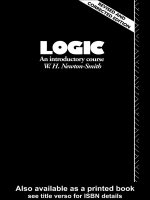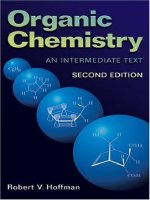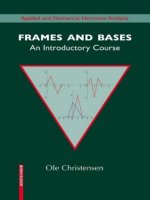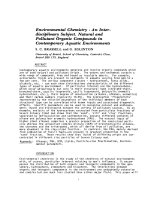Organic chemistry an introductory course
Bạn đang xem bản rút gọn của tài liệu. Xem và tải ngay bản đầy đủ của tài liệu tại đây (7.69 MB, 201 trang )
This book is sold subject to the conditions that
it shall not, by way of trade, be lent, re-sold,
hired out, or otherwise disposed of without the
publisher's consent, in any form of binding or
cover other than that in which it is published.
www.pdfgrip.com
Organic
Chemistry
AN INTRODUCTORY COURSE
BY
H . L O W T H E R B . S c , M.Ed.
PERGAMON PRESS
OXFORD · L O N D O N · EDINBURGH · PARIS · F R A N K F U R T
THE MACMILLAN COMPANY
NEW
YORK
www.pdfgrip.com
PERGAMON PRESS LTD.
Headington Hill Hall, Oxford
4 & 5 Fitzroy Square, London WA
PERGAMON PRESS (SCOTLAND) LTD.
2 & 3 Teviot Place, Edinburgh 1
THE MACMILLAN COMPANY
60 Fifth Avenue, New York 11, New York
COLLIER-MACMILLAN CANADA, LTD.
132 Water Street South, Gait, Ontario, Canada
GAUTHIER-VILLARS ED.
55 Quai des Grands-Augustins, Paris 6
PERGAMON PRESS G.m.b.H.
Kaiserstrasse 75, Frankfurt am Main
Copyright © 1964
PERGAMON PRESS LTD.
Library of Congress Catalog Card No. 63-21100
Set in 10 on 12 pt. Times Roman and printed in
Northern Ireland at The Universities Press, Belfast
www.pdfgrip.com
Preface
book, which does not assume any previous knowledge of
Organic Chemistry, is suitable for use throughout the Advanced
level course of the General Certificate and in other courses of
similar standard.
During his thirty-two years as a teacher, the author has seen
significant changes in the style and content of introductory text
books of Organic Chemistry. Modern developments, especially
in industry; greater emphasis on physico-chemical principles; a
widening of scope to satisfy the requirements of the Universities
and of a variety of examination syllabuses—these, and other
considerations have contributed towards the wealth of information
now contained in the introductory text. The large numbers of
students now taking advanced courses represent a considerable
ability range, however; with the result that modern texts are
often too diffuse, in the author's experience, for the majority of
those who must use them. It seems, therefore, that there is a
need for books which, whilst keeping new developments in view,
concentrate on stating the basic principles and reactions clearly
and concisely. This is the author's present aim.
In writing a book of limited size, many problems of selection
and treatment arise, if scope and clarity are not to be sacrificed.
Nevertheless, this book is in no sense a collection of notes. On
the contrary, there is ample material herein to satisfy the needs of
any student undertaking a first course of Organic Chemistry.
Nothing of importance is consciously omitted. Industrial appli
cations are mentioned and there is a separate chapter about
some of the more important of these. To make the book a
THIS
vii
www.pdfgrip.com
viii
PREFACE
self-contained unit without disrupting the continuity of the text,
relevant physico-chemical principles are discussed in the last
chapter. The exercises illustrate the text, most sets covering several
chapters each to co-ordinate the subject matter.
In all, these comparatively few pages carry the essential features
of a modern first course, approached with a purposeful directness
which, the author feels, will be advantageous to the reader.
www.pdfgrip.com
Acknowledgements
wishes to thank the following individuals and bodies
for supplying material for this book and for giving their kind
permission for its inclusion:
Mr. M. Schofield, M.A., F.R.I.C., author of the article
"Chemistry in the Forest" and Miss Jane O'Malley of the
Ě and  Publicity Department for the block illustrating wood
distillation in the Forest of Dean.
Mr. A. G. Hervey of the Petroleum Information Bureau and
Mr. K. Hutchinson of the National Coal Board for information
concerning petroleum and natural gas.
Mr. N. Kirkland and Mr. R. Senior of the Public Relations
Department of the Esso Petroleum Company for the photograph
and the diagram illustrating petroleum distillation.
Mr. E. Webb, B.Sc, for his photographs of atomic models.
The author is indebted to his wife and to Mr. H. G. Burks,
A.R.S.M. for their help in the reading of the proofs.
THE AUTHOR
ix
www.pdfgrip.com
1
Characteristic Features
F O R T H O U S A N D S of years chemistry has been employed as the
means to an end in, for example, metallurgy, pottery, perfumery,
brewing, dyeing and pharmacy. Thus, when the era of chemistry
as a science began some 300 years ago, a large number of useful
substances of unknown composition awaited classification. This
was carried out on the basis of origin—animal, vegetable or
mineral. In the course of time compounds derived from living
organisms, animal or vegetable, came to be called "organic" and
those of mineral origin "inorganic".
This classification persisted until the early years of the 19th
century when it was thought that the living source of organic
compounds was of fundamental importance because (a) newly
developed analytical techniques showed that they all contained
carbon combined with a few other non-metallic elements, in
contrast with the wide range of composition of mineral derivatives;
(b) it had not yet been found possible to synthesise an organic
compound in the laboratory.
In 1828, however, Wöhler synthesised urea, a typical product of
animal metabolism, from mineral reagents (potassium cyanide,
lead oxide and ammonium sulphate). Other syntheses of a
similar nature followed, not only of carbon compounds which
had already been obtained from living sources, but of an even
larger number of hitherto unknown carbon compounds which had
no counterpart in nature. In this way the "living source" theory
1
www.pdfgrip.com
2
ORGANIC
CHEMISTRY
was abandoned, although the term "organic" was retained with
a new meaning, viz. "containing carbon".
According to the modern system of classification by com
position, then, organic compounds are those containing the element
carbon, irrespective of their source. Inorganic compounds are
compounds of all the other elements, although it is convenient to
include the oxides of carbon and the carbonates in this category.
The elements of organic chemistry
The metabolism of our bodies depends on regular supplies of
organic materials. These include:
from cereals, potatoes
(a) Carbohydrates: starch* {C%\i1{ß^x
and bread, and the common sweetening agent sucrose (cane
sugar) C 1 2H 2 2 0 n , both of which are digested into glucose
C 6 H 1 20 6 .
(b) Proteins, chiefly from animal cells. There are many proteins,
all having approximately the same composition, viz. 50%
carbon, 25% oxygen, 15% nitrogen, 7% hydrogen and up to
5% sulphur.
(c) Fats, e.g. stearin C 5 7 H 1 1 0O 6 in beef and mutton fats.
(d) Vitamins, e.g. vitamin A, C 2 0H 3 0O and vitamin D, C 2 8 H 4 4 0 .
In addition to these food materials, most people are familiar
with acetic acid C 2 H 4 0 2 in vinegar; hydrocarbon petroleum
products like petrol, paraffin oil and petroleum jelly ("Vaseline");
naphthalene C 1 0H 8 in firelighters and mothballs; alcohol C 2 H e O
in intoxicating drinks and "meths"; aspirin C 9 H 8 0 4 ; nicotine
C 1 0 H 1 4 N 2 in tobacco; anaesthetics, such as ether C 4 H 1 0O and
chloroform CHC1 3; explosives, e.g. nitroglycerine C 3 H 5 N 3 0 9 (in
dynamite) and TNT C 7 H 5 N 3 0 6 ; plastics, e.g. Perspex ( € 5 Η 8 0 2 ) Χ ;
polythene ( C H ^ and PVC (QHgCl)^ DDT insecticide C 1 4H 9 C1 5 .
This very short list is nevertheless representative of organic
compounds as a whole. It shows that organic molecules are often
* It is customary to represent the molecular formula of a substance of high,
but not exactly known, molecular weight by V times its empirical (simplest)
formula. In this case, V probably lies between 200 and 350.
www.pdfgrip.com
CHARACTERISTIC
FEATURES
3
big and that the elements normally present in them, in addition
to carbon, are few, viz: hydrogen and oxygen (very common),
together with nitrogen, sulphur and halogens.
These few elements are essential for plant and animal meta
bolism and may be regarded as the basic materials of many
aspects of modern civilisation. Not the least important of their
applications is in the process of education, which would be
seriously hampered by the lack of writing ink (derived from gallic
acid C 7H 60 5) , paper and books. For example, this book is
chiefly composed of cellulose* (CeK10O5)x in the form of paper,
cotton thread and cloth; printer's ink, which is amorphous
carbon suspended in a drying oil, like linseed oil (derived from
glycerine C 3 H 8 0 3 and linolic acid C 1 8H 3 20 2 ) ; glue (a mixture of
peptones from animal proteins) and starch paste.
The carbon atom
The idea of valency as a number denoting the combining
capacity of an element was first put forward by Frankland in
1852. Six years later, Kekulé postulated the quadrivalency of
carbon and in 1865 Crum Brown introduced the method of
representing each valency separately. Thus the carbon atom was
thought to have four bonds, of unknown nature, through the
agency of which it could combine with four monovalent, or two
divalent, atoms.
Η
Η—C—Η
0=C=0
I
Η
Methane
Carbon dioxide
The four bonds were tacitly assumed to be in one plane until
1874, when van't Hoff and Le Bel independently put forward a
space theory. According to this theory, the carbon atom was
represented as being at the centre of a regular tetrahedron with
the valency bonds directed towards the corners (Fig. 1, p. 4).
* Compare starch. In this case, * V * is probably in the region of 2000.
www.pdfgrip.com
4
ORGANIC CHEMISTRY
The bonds were thus symmetrically distributed about the atom,
the angle between each pair being 109J°.
FIG.
1
This three-dimensional carbon atom is still the basis of organic
formulae and most laboratories have boxes of atomic models
which are used to build space formulae of organic molecules
(p. 6). These models should be used as often as possible because
the original two-dimensional method, which must still be used in
writing formulae, may be misleading. For example, there are
two ways of representing CH 2C1 2 on paper.
Η
CI
Η—C—CI
CI—C—CI
Η
Η
FIG.
2
www.pdfgrip.com
5
CHARACTERISTIC FEATURES
These formulae are, in fact, identical because the two chlorine
atoms are always next to each other in the space model (Fig. 2).
For 75 years, then, the symmetrical distribution in space of the
four valency bonds about the carbon atom has been accepted.
The only modification is that the modern electronic theory has
explained the nature of the bond.*
The atomic number of carbon is 6 and its atomic weight is 12.
Thus the carbon atom has a nucleus of 6 protons and 6 neutrons,
surrounded by 6 planetary electrons in two shells. The first
shell contains the stable duplet of helium leaving an incomplete
second shell of 4 valency electrons. This atom combines by
directional covalency with other non-metallic atoms, sharing a
further 4 electrons to gain the stable electronic arrangement of
neon. Thus the modern formula for methane is
Η
Η
or
I
Η ; C? Η
Η—C—Η
Η
i
=
5
C
valency
electrons
electrons
χ
,·= Η
Note that (a) it is customary to show only valency electrons;
(b) the formula has to be represented in one plane, although the
molecule is, in fact, three-dimensional; (c) a bond represents a
shared pair of electrons, one from each atom.
The structure of carbon compounds
There are literally hundreds of thousands of carbon compounds
so that they easily outnumber the compounds of all the other
elements put together. Yet carbon combines with very few
elements (p. 3). The explanation of this paradox lies in the
* The modern theories of atomic structure and valency are briefly discussed
in Chapter 20.
www.pdfgrip.com
ORGANIC CHEMISTRY
FIG.
3
FIG.
4
www.pdfgrip.com
CHARACTERISTIC
7
FEATURES
apparently limitless capacity of carbon atoms for joining on to
each other to form open chains and closed rings.
—c—
-c—c—c—c-
I
I
I
c—c—c—
I
"Straight"
Open chain or
aliphatic compounds
C
c
c
Closed ring or
cyclic compounds
Atomic models readily show that a chain of more than two
carbon atoms is not really straight. When we speak of a "straight
chain" we mean an "unbranched chain", such as that in normal
butane, C 4 H 10 (see Figs. 3 and 4 opposite).
These space arrangements may appear to be different but, in
fact, they both represent the same molecule and they are both
written on paper in the same way, thus:
Η
Η Η Η
l i l i
Η—C—C—C—C—Η
l i l i
Η Η Η Η
It should be realised, however, that this is only a convenient
method of expressing a three-dimensional molecule on paper.
www.pdfgrip.com
8
ORGANIC CHEMISTRY
It would be just as correct to represent this molecule as
Η
Η
I
H—C
Η
Η
I
I
Ο
Ι
Η—C—Η
I
Η
Η
I
Η—C—Η
Η
-C—Η
Η
Η—C
or
C—Η
Η
Η—C—Η
Η ·
In all three representations there is a "straight" (i.e. unbranched)
chain of four carbon atoms, with three hydrogen atoms attached
to each of the end carbon atoms and two to each of the others.
In other words, all three representations conform to the same
a e
rational formula of C H 3 C H 2 C H 2 C H 3 ( p g 9). This use of
the rational formula is worth remembering.
With regard to closed rings, the strain theory of von Baeyer
(1885) and its modern counterpart, the concept of directional
covalency, are important. The normal angle between the valency
bonds is 109J° and distortion leads to an unstable molecule.
Now, of the regular figures, the pentagon has angles (108°)
corresponding most closely to 109J°, so that a closed ring of five
carbon atoms in one plane (as shown on p. 7) requires very little
distortion. Rings of four or three carbon atoms are less stable,
although they are known to exist. Similarly, any number of
carbon atoms over five produces distortion.
Organic formulae
Every inorganic compound has a "formula", by which is
normally meant its molecular formula. In some cases, however,
the formula is actually the empirical, or simplest, formula. Such
www.pdfgrip.com
CHARACTERISTIC FEATURES
9
is the case with water, the properties of which indicate that the
some of the
molecular formula should be (U20)x—compare
organic compounds listed on page 2.
In organic chemistry, five types of formula are in common use.
For example, acetic acid has
(a) an empirical formula H 2 CO, found by quantitative analysis,
(b) a molecular formula H 4 C 2 0 2 , corresponding to the observed
molecular weight of 60,
(c) a rational formula CH 3 -COOH, showing the grouping of the
atoms, as indicated by the observed chemical properties,
(d) a structural formula
Η O
Η—C—C—Ο—Η
I
Η
showing the individual linking of the atoms,
(e) a space formula
\
\
FIG.
5
The importance of structural formulae is illustrated later
(p. 13).
Homologous series
In view of the abundance of carbon compounds it is a great
convenience to be able to subdivide them into a comparatively
small number of groups which are known as homologous series.
www.pdfgrip.com
10
ORGANIC CHEMISTRY
Each of these series corresponds to a group of compounds which
(a) all contain the same elements and can all be represented by a
single general formula,
(b) all have similar chemical properties,
(c) have the common increment of CH 2 between successive
members of the series,
(d) show a gradual variation in physical properties with increasing
molecular weight.
These points are clearly illustrated by the homologous series
of the paraffin hydrocarbons (p. 27).
Radicals and typical groups
Groups of elements (or "radicals") which may behave as single
units are known in inorganic chemistry (e.g. = S 0 4 , = C 0 3 ,
— N 0 3 and NH 4—), but compounds consisting entirely of such
radicals (e.g. ammonium nitrate N H 4 N 0 3 ) are comparatively
rare. The reverse is true in organic chemistry. Single atoms
rarely play a part in the constitution of organic molecules, which
are usually composed of two or more radicals as shown in their
rational formulae (p. 9).
The commonest radicals are the alkyl groups, each containing
one hydrogen atom less than the paraffin hydrocarbon from which
it is derived and named.
Methane, CH 4, gives methyl CH 3—
Ethane, C 2H 6, gives ethyl C 2H 5—
Propane, C 3H 8, gives propyl C 3H 7—
Alkyl groups occur in all homologous series, associated with a
typical group which varies from series to series. This is the group
which is assigned to all members of a given homologous series
in accordance with their common chemical properties. Some
typical groups are
Hydroxyl —OH
Carbonyl =CO
Carboxyl (two associated groups) —COOH
Amino — N H a
Cyanide —CN
www.pdfgrip.com
11
CHARACTERISTIC FEATURES
EXAMPLES
Alcohols, ( C n H 2
Methyl alcohol
Ethyl alcohol
Propyl alcohol
etc.
nl O
+
H)
CH3OH
C 2H 5O H
C 3H 7O H
Amines, ( C „ H 2
Methyl amine
Ethyl amine
Propyl amine
etc.
+
n i N H 2)
C H
3N
H
2
C 2H 6N H
2
C 3H 7N H
2
The commonest single atoms of organic compounds are
(a) chlorine, as in the alkyl chlorides CH 3C1, C 2H 5C1, etc.,
(b) oxygen, as in the ethers (CH 3) 20, (C 2H 5) 20, etc.
Isomerism
The molecular formula of an inorganic compound is deter
minate, representing only one compound. This is not necessarily
so in organic chemistry. For example, camphor has the molecu
lar formula C 1 0H 1 6O, but there are 119 other substances which
also have this same molecular formula! These 120 isomers, having
the same molecular formula but different properties, are dis
tinguished by their structural formulae.
Taking a simple example, two substances of molecular formula
C 2 H 6 0 are known. Substance A is a colourless, volatile liquid;
substance Β is a gas. If the valencies of the constituent atoms are
to be satisfied, there are only two possible arrangements (below).
But which structure belongs to A and which to Β ? This is decided
by their chemical properties. For example, the two substances
behave towards the phosphorus chlorides (PC13 and PC15) as
follows:
A—reacts readily with both chlorides, forming ethyl chloride;
C 2 H 6 0 -* C 2H 5C1. Here, a monovalent chlorine atom has re
placed both an oxygen atom and a hydrogen atom, which must
therefore together form a monovalent hydroxyl group —OH.
Β—has no simple reaction with the pentachloride under any
conditions, but forms methyl chloride CH3C1 with the aid
of heat and pressure when added to phosphorus trichloride.
www.pdfgrip.com
12
O R G A N I C CHEMISTRY
In this kind of way the structures are assigned:
Η Η
I I
Η—C—C—Ο—Η
I I
Η
Η
I
I
Η—C—O—C—Η
I
Η Η
Η
C H 8C H 2O H
A—ethyl alcohol
I
Η
C H 8- 0 - C H 8
Β—dimethyl ether
It is important to remember that structural and rational
formulae, by means of which isomers are distinguished from each
other, depend on the observed chemical properties, as indicated
above. The chemical properties of a substance cannot be changed
simply by rearranging its structure on paper!
Types of reaction
Substitution occurs when an atom or radical takes the place of
another atom or radical of the same valency. For example, when
equal volumes of methane and chlorine react together, methyl
chloride and hydrogen chloride are formed as shown by the
equation
CH 4 + Cl 2 = CH3CI + HCl
Here, a monovalent chlorine atom has taken the place of a mono
valent hydrogen atom. Substances which behave exclusively in
this way are said to be "saturated".
Addition takes place when a molecule of substance A adds on a
molecule of substance Β to form one molecule AB only. For
example, ethylene C 2H 4 reacts with chlorine in this way.
C 2H 4 + Cl 2 = C 2H 4C1 2
Similarly, acetaldehyde adds on ammonia.
C 2 H 4 0 + N H 3 = C 2H 7NO
For this reason, ethylene and acetaldehyde are described as
"unsaturated" compounds.
Condensation is a reaction in which a number of simple mole
cules (not necessarily the same) build up into a complicated
www.pdfgrip.com
CHARACTERISTIC
13
FEATURES
molecule. For example, formaldehyde and ammonia react in
accordance with the equation
6CH 20 + 4NH 3 = C 6 H 1 2N 4 + 6 H 2 0
The molecules of the reacting substances have four atoms each;
the molecule of the main product contains 22 atoms.
Polymerisation is a special type of condensation common
amongst unsaturated compounds, which, as we saw above, react
by addition. All of the combining molecules must be the same
and there must be only one product, having the same empirical
formula as the original substance and a molecular weight which is
an exact multiple of the original molecular weight. Thus, heat
causes acetylene to polymerise to benzene (the empirical formula
of both is CH).
=
3C 2H 2 CgHfl
The polymer (benzene C 6H e) is in this case a "trimer" of the
original acetylene because three molecules are involved.
The very complicated molecules of modern synthetic materials
like Nylon, Perspex, PVC, Terylene and polythene are built up from
simpler organic molecules by condensation and polymerisation.
Mechanism equations
The use of molecular formulae in an equation representing
an organic reaction supplies limited information only. If struc
tural formulae are used, however, the mechanism of the reaction
can be illustrated. Take, for example, the substitution and
additions of the last section.
Substitution of chlorine for hydrogen in methane.
CH 4 + Cl 2 = CH3CI +
Η
HCl
Η
Η—C—ΙΗ + CÍ J CI = Η—C—CI + Η—CI
www.pdfgrip.com
14
ORGANIC
CHEMISTRY
Addition of chlorine to ethylene.
C 2H 4 + Cl 2 = C2H4C1<
Η Η
Η Η
Η—C=C—Η
ΐ Τ
* Η—C—C—Η
CI C1
CI C1
Addition of ammonia to acetaldehyde.
Η—C—C = Ο
I
ΐ
Τ
> Η—C—C—ΟΗ
Η ΝΗ2
Η ΝΗ 2Η
Rational formulae, which occupy less space than structural
formulae, are also preferable to molecular formulae. Take the
substitution of chlorine for hydrogen in acetic acid C 2H 4O a , to
form trichloracetic acid.
C 2 H 4 0 2 + 3C12 - C 2HC1 30 2 + 3HC1
CH3COOH + 3C12 = CCI3COOH +
3HC1
The first equation tells us that three of the four hydrogen atoms
of the acetic acid molecule have been replaced by chlorine atoms;
the second makes it clear that three similarly placed hydrogen
atoms are substituted, leaving the acidic —COOH group un
affected.
The multiple bond
The structural formulae of the two unsaturated compounds
mentioned above—ethylene and acetaldehyde—both include a
double bond ( C = C and C=0). This is best explained on the
basis of the electronic theory (Chapter 20).
In the ethylene molecule, each carbon atom achieves its octet
by sharing two of its four valency electrons ( x ) with hydrogen
atoms and two with the other carbon atom, as shown. This
www.pdfgrip.com
CHARACTERISTIC FEATURES
15
constitutes two bonds between the carbon atoms, which entails
considerable distortion (Fig. 6).
Η Η
Ηi C
Cχ Η
í
FIG.
6
The double bond is therefore a source of strain in the molecule
and the bonds are ready to assume the stable arrangement
whenever a suitable additive reagent is present (Fig. 7).
Η Η
H;C;
c; Η
X
ΐ
:C1:
:C1:
FIG. 7
www.pdfgrip.com
16
ORGANIC
CHEMISTRY
This explanation holds good for the C = 0 bond of acetaldehyde
and for other multiple bonds, such as the treble (triple) bond of
acetylene HC=CH and the cyanide radical — G = N . All three
types (CC, CO, CN) have the additive property in common and,
in fact, all of them add hydrogen. In general, however, each has
its own characteristic addition reactions. Thus the addition of
chlorine (above) is characteristic of CC bonds; it does not occur
with CO and CN bonds.
Nomenclature
If a pharmacist is asked for "spirit of salt" or "lunar caustic",
he will oblige with hydrochloric acid and silver nitrate respectively.
Similarly, old names still survive in organic chemistry. Some
relate to the original source, like "formic acid" (Latin, formica—
the ant); some have no obvious meaning, like "alcohol". This
is a pity, because the systematic nomenclature is both simple and
informative, as in inorganic chemistry.
Substitution compounds may be named in two ways: (a) accord
ing to the radicals they contain; (b) according to the reactants
which produce them. For example, when chlorine substitutes
methane (CH 4), the product CH 3C1 may be called either methyl
chloride (two words) or monochloromethane (one word). Notice
that in the latter method, the name is, so to speak, in reverse.
The original substance comes last, preceded by the substituting
substance, which is preceded in turn by the number of atoms of
chlorine which have been introduced.
Addition compounds are usually named after the reacting sub
stances. Thus the two addition compounds of page 12 are
called ethylene dichloride and acetaldehyde ammonia (two
words).
Rate of reaction
Reactions between electrovalent inorganic compounds when
dissolved in water are rapid. Thus, a dense pale yellow precipitate
of silver bromide is immediately formed on mixing aqueous
www.pdfgrip.com
CHARACTERISTIC FEATURES
17
solutions of silver nitrate and sodium bromide at ordinary temperat U r C S
'
Ag+NOj + Na+Br- = Ag+Br~¿ + Na+NOg
In this case, the reacting "molecules" are better described as
"ionic aggregates", bound together by mutual attraction but
ready to react in the right conditions, viz: in aqueous solution.
Organic compounds are covalent and there are two main types
to consider, as follows.
Saturated substances, which form substitution compounds
(p. 12), usually react very slowly at ordinary temperatures. Even
when the conditions are made more favourable by (e.g.) applying
heat in the presence of a common solvent, the reaction may still
take an appreciable time to complete. For example, if ethyl
bromide, which is insoluble in water, is shaken with aqueous
silver nitrate, a slight precipitate is produced (contrast above).
If alcohol is used as the common solvent for both substances a
better reaction is observed, but heat is still needed to increase the
rate of precipitation.
Unsaturated substances may well form their addition compounds
rapidly at ordinary temperatures, since the preliminary removal
of an atom or radical is not involved, as it is in substitution.
Nevertheless, some additions are more difficult than others,
needing heat and/or the presence of a catalyst for quick reaction.
From the above general observations, it is clear that it is not
sufficient to be able to name the substances used in a given
reaction. The most satisfactory reaction conditions are just as
important. It would be misleading to say that "sodium bromide
and silver nitrate immediately form a precipitate" without
mentioning water. Similarly, the phrase "in hot alcoholic solution" is essential in describing the formation of silver bromide
from ethyl bromide and silver nitrate.
Apparatus and experimental technique
Most of the organic compounds discussed in this book are
liquids, many of them very volatile. Further, heat is generally
www.pdfgrip.com
18
ORGANIC
CHEMISTRY
needed to promote organic reactions. These two points are
illustrated by the apparatus in common use.
The reflux apparatus (Fig. 8) is very useful for prolonged reac
tions involving hot liquids. Vapour, which would otherwise
escape, is condensed and returned to the reaction vessel. In
this way, both reactants and products which are volatile are
confined, no matter how long the reaction takes to complete.
The distillation apparatus (Fig. 9) is used when the reaction takes
place more rapidly on heating and it is desired to remove the
volatile product as it is formed. The cork (C) may carry a dropping
funnel (for adding more liquid as required) or a thermometer
(if the temperature is important)—or possibly both. The wire
gauze (W) may be substituted by a water bath or a sand tray
for controlled heating at various temperatures. The adapter (A)
www.pdfgrip.com
19
CHARACTERISTIC FEATURES
leads the condensed liquid into the receiver, which is placed in
ice if the distillate is very volatile.
FIG. 9
If the reactants are volatile, they will distil unchanged to a
certain extent. There may also be volatile by-products. Hence
purification of the distillate is essential, as follows:
The separating funnel (Fig. 10) is often used in the course of
purification. Many organic liquids are insoluble in
water and impurities are usually extracted from them
by agitation with suitable aqueous solutions. On
standing, the purified liquid and the aqueous solution
separate into two layers, the lower of which may be
run off by opening the tap (T). According to their
respective densities, this lower layer may be the aqueous
purifying solution (discarded) or the required organic
liquid.
The fractioning column (Fig. 11) facilitates the sepa
ration of volatile liquids which are mutually soluble.
The homogeneous mixture is heated and the vapour,
containing a high proportion of the most volatile
FIG. 10
χ









